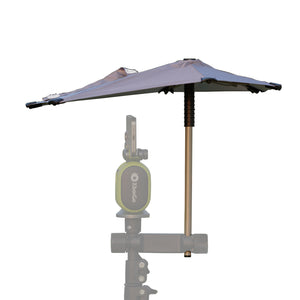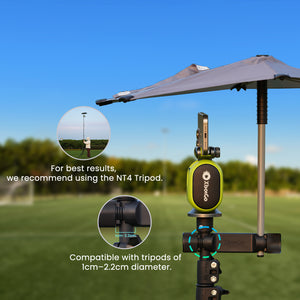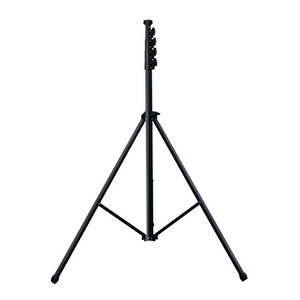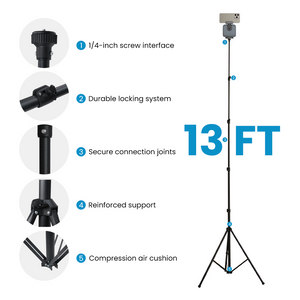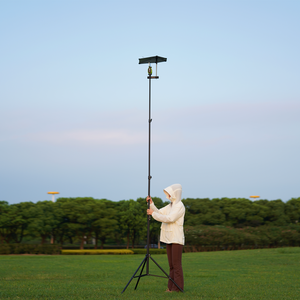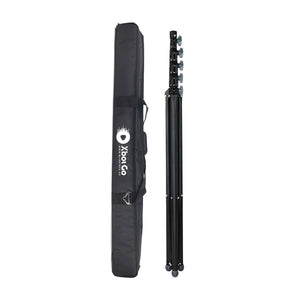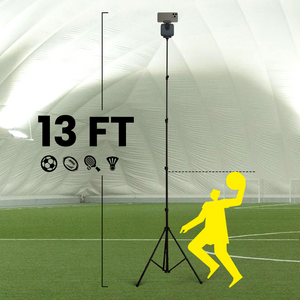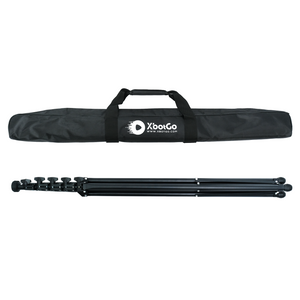XbotGo Chameleon AI Sports Camera
So funktioniert das Punktesystem im Eishockey: Ein umfassender Leitfaden für neue Fans und Eltern
Du schaust dir das erste Hockeyspiel deines Kindes an und jubelst jedes Mal, wenn es den Puck berührt. Die Anzeigetafel zeigt einen 4:2-Sieg an, doch dann hörst du einen anderen Elternteil sagen, sein Kind habe „heute Abend drei Punkte geholt“. Moment mal – wie kann ein Spieler drei Punkte bekommen, wenn das Team nur vier Tore erzielt hat?
Willkommen bei einer der häufigsten Verwirrungsquellen im Eishockey: dem Punktesystem. Egal, ob Sie ein neuer Fan sind, als Elternteil die Statistiken Ihres Kindes verstehen möchten oder als erfahrener Zuschauer fortgeschrittene Konzepte begreifen wollen – dieser Leitfaden erklärt Ihnen alles zum Punktesystem im Eishockey.
Die zwei Arten von Hockeypunkten
Hier ist die grundlegende Wahrheit, die Neulinge oft verwirrt: Im Eishockey werden „Punkte“ verwendet, um zwei völlig unterschiedliche Dinge zu messen. Sobald man diesen Unterschied verstanden hat, ergibt alles andere Sinn.
Spielerpunkte: Tore und Vorlagen
In der Welt der Spielerstatistik messen Punkte den individuellen Offensivbeitrag. Die Formel ist bestechend einfach:
Spielerpunkte = Tore + Vorlagen
Für jedes Tor, das ein Spieler erzielt, erhält er einen Punkt in seiner persönlichen Statistik. Für jede Torvorlage erhält er ebenfalls einen Punkt. Das ist alles. Erzielt ein Spieler in einer Saison 25 Tore und 40 Torvorlagen, kommt er auf 65 Punkte.
Jetzt wird es interessant: Bis zu drei Spieler können Punkte für ein einzelnes Tor erzielen. Nehmen wir an, Spieler A passt zu Spieler B, der zu Spieler C passt, der das Tor erzielt. In diesem Szenario:
- Spieler C erhält 1 Punkt (Tor)
- Spieler B erhält 1 Punkt (primäre Vorlage).
- Spieler A erhält 1 Punkt (sekundäre Vorlage).
Dieses System erkennt an, dass Tore im Eishockey selten isoliert entstehen – sie sind in der Regel das Ergebnis von Teamwork und klugen Passkombinationen.
Teampunkte: Tabelle und Playoffs
Teampunkte funktionieren nach einer völlig anderen Skala und bestimmen die Platzierung in den Playoffs. In der NHL funktioniert das System folgendermaßen:
- Sieg (jeglicher Art): 2 Punkte
- Niederlage nach Verlängerung/Shootout: 1 Punkt
- Regulierungsverlust: 0 Punkte
Als die Vegas Golden Knights die Seattle Kraken in der Verlängerung mit 4:3 besiegten, erhielt Vegas 2 Punkte in der Tabelle, während Seattle 1 Punkt dafür erhielt, dass das Spiel über die reguläre Spielzeit hinausging.
Häufige Verwirrung aufgeklärt
Die Verwirrung entsteht meist dadurch, dass wir für beide Systeme dasselbe Wort – „Punkte“ – verwenden. Eine Mannschaft kann 3:2 gewinnen (3 Tore erzielen) und dabei 2 Punkte in der Tabelle erhalten. Gleichzeitig kann ein Spieler im selben Spiel „4 Punkte“ haben, indem er ein Tor erzielt und alle anderen vorbereitet hat.
Man kann es sich so vorstellen: Spielerpunkte messen die Offensivleistung, während Teampunkte Siege und Niederlagen für die Playoff-Platzierung widerspiegeln. Sie werden auf völlig unterschiedlichen Skalen und für völlig unterschiedliche Zwecke gemessen.
Wie Spielerpunkte wirklich funktionieren
Lassen Sie uns das Spielerpunktesystem genauer betrachten und mit den beiden Komponenten beginnen, die für Stürmer, Verteidiger und alle, die die individuelle Leistung verfolgen, am wichtigsten sind.
Ziele: Die primäre Währung
Die Torregel folgt dem Prinzip der „letzten Puckberührung“ im Eishockey: Der Spieler der angreifenden Mannschaft, der den Puck als Letzter berührt, bevor dieser die Torlinie vollständig überquert, erhält das Tor. Daraus ergeben sich einige interessante Spielsituationen:
- Direkte Schüsse: Der Spieler schießt, der Puck geht ins Tor = Tor des Spielers
- Abpraller von Mitspielern: Wenn dein Schuss vom Schläger oder Körper eines Mitspielers abgelenkt wird, erhält dieser das Tor.
- Abpraller von Gegenspielern: Wenn Ihr Schuss von einem Gegenspieler abgefälscht wird, zählt er trotzdem als Tor.
- Eigentore: Wenn ein Verteidiger den Ball versehentlich ins eigene Tor befördert, erhält der Angreifer, der den Ball zuletzt berührt hat, das Tor.
Diese Regel zur letzten Puckberührung hat strategische Auswirkungen. Teams positionieren ihre Spieler oft gezielt vor dem Tor, um Schüsse abzuwehren und es den Torhütern so zu erschweren, die Flugbahn des Pucks zu verfolgen. Deshalb sieht man Spieler oft in den umkämpften Bereichen nahe des Torraums um die beste Position kämpfen.
Saison-Benchmarks für die Torausbeute:
- 50+ Tore: Elite-Niveau, das erreichen nur 1-2 Spieler pro Saison.
- Über 40 Tore: Eine hervorragende Saison, nur wenige Spieler erreichen diese Marke.
- 30+ Tore: Sehr gut für Haupttorschützen
- Über 20 Tore: Zuverlässiger Spieler für die Stürmerreihe
- 15+ Tore: Hervorragend für Verteidiger
- 10+ Tore: Gut für defensive Verteidiger
Assists: Der Teamwork-Faktor
Torvorlagen würdigen die Vorarbeit, die zu Toren führt. Die NHL vergibt bis zu zwei Torvorlagen pro Tor:
Primäre Torvorlage: Der letzte Pass vor dem Tor. Dieser Spieler hat den Torschützen direkt in Szene gesetzt.
Zweiter Assist: Der Pass vor dem ersten Assist. Damit wird der Spieler gewürdigt, der die Torchance eingeleitet hat.
Betrachten wir folgendes Beispiel aus einem realen Spiel: Connor McDavid führt den Puck in die Angriffszone und passt zu Leon Draisaitl. Draisaitl spielt den Puck schnell zu Zach Hyman, der das Tor erzielt. Die Punkteverteilung:
- Hyman: 1 Punkt (Tor)
- Draisaitl: 1 Punkt (primäre Vorlage)
- McDavid: 1 Punkt (zweiter Assist)
Assists zählen bei der Punktewertung genauso viel wie Tore, was den mannschaftsorientierten Charakter des Eishockeys unterstreicht. Manche Spieler, insbesondere Spielmacher in der Mitte und offensive Verteidiger, bauen ihre Karriere eher darauf auf, Tore für ihre Mitspieler vorzubereiten, als selbst Tore zu erzielen.
Punkte-Benchmarks nach Position
Vorwärts:
- Über 100 Punkte: Eine wirklich herausragende Saison (man denke an McDavid, MacKinnon)
- 80-90 Punkte: Ausgezeichnet, All-Star-Kaliber
- 60-70 Punkte: Sehr guter Topspieler
- 40-50 Punkte: Solider Stürmer der mittleren Reihen
- 20-30 Punkte: Defensivspezialist oder Viertreihenspieler
Verteidiger:
- 70+ Punkte: Offensivstarker Verteidiger der Spitzenklasse (selten)
- 50-60 Punkte: Hervorragender Offensivspieler
- 40 Punkte: Sehr guter offensiver Verteidiger
- 20-30 Punkte: Solider Zwei-Wege-Verteidiger
- 10-20 Punkte: Defensivspezialist
Zum Vergleich: Wayne Gretzky hält die Rekorde mit 894 Karrieretoren und 1.963 Karrierevorlagen, was insgesamt 2.857 Punkten entspricht. Kein anderer Spieler hat je die 2.000-Punkte-Marke geknackt. Unter den aktiven Spielern haben nur Sidney Crosby und Alex Ovechkin mehr als 1.500 Karrierepunkte erzielt.
Erläuterung der Teampunkte und der Tabellenplatzierung
Nun wollen wir uns darauf konzentrieren, wie die Teams Punkte in der Tabelle sammeln – auf das System, das letztendlich darüber entscheidet, wer in die Playoffs kommt.
Das aktuelle NHL-System
Das 2-1-0-Punktesystem der NHL mag auf den ersten Blick seltsam erscheinen, aber es steckt Logik dahinter:
Warum gibt es 2 Punkte für einen Sieg?
Dies ist seit den Anfängen der Liga der Standard. Zwei Punkte Unterschied zwischen Sieg und Niederlage sorgen dafür, dass jedes Spiel Bedeutung hat und die Tabellenberechnung relativ einfach bleibt.
Warum gibt es 1 Punkt für Niederlagen in der Verlängerung/im Elfmeterschießen?
Jetzt wird es interessant. Mannschaften, die ein Spiel in die Verlängerung bringen, haben sich das Unentschieden nach 60 Minuten regulärer Spielzeit quasi „verdient“. Der Bonuspunkt würdigt diese Leistung und belohnt den späteren Sieger dennoch mit vollen 2 Punkten.
Die Mathematik des Wettbewerbs:
Dieses System führt zu einer ungewöhnlichen Besonderheit: Spiele nach regulärer Spielzeit bringen insgesamt 2 Punkte (2:0), während Spiele nach Verlängerung insgesamt 3 Punkte (2:1) bringen. Manche Spiele sind in der Tabelle also tatsächlich mehr wert als andere.
Historische Entwicklung
Um das aktuelle System zu verstehen, ist ein Blick in die Geschichte des Eishockeys notwendig:
Vor 1999: Spiele konnten nach einer fünfminütigen Verlängerung unentschieden enden. Beide Mannschaften erhielten bei einem Unentschieden einen Punkt.
1999–2004: Die NHL führte den „Verliererpunkt“ für Overtime-Niederlagen ein, um ein aggressiveres Spiel in der Overtime zu fördern. Die Teams spielten zu defensiv und schützten ihren garantierten Gleichstand.
2005–heute: Das Shootout wurde eingeführt, um Unentschieden vollständig auszuschließen. Das Punktesystem blieb unverändert: 2 Punkte für jeden Sieg, 1 Punkt für eine Niederlage nach Verlängerung/Shootout, 0 Punkte für eine Niederlage nach regulärer Spielzeit.
Diese Entwicklung spiegelt die allgemeine Abneigung nordamerikanischer Sportarten gegen Unentschieden und den Wunsch der NHL nach spannenderen Verlängerungen wider. Da beiden Teams durch das Erreichen der Verlängerung mindestens ein Punkt garantiert wird, spielen die Mannschaften theoretisch aggressiver, um den zweiten Punkt zu sichern.
Tiebreaker-Regeln
Bei Punktgleichheit zweier Mannschaften wendet die NHL die folgenden Tiebreaker-Regeln in dieser Reihenfolge an:
- Weniger Spiele (nur während der Saison)
- Siege nach regulärer Spielzeit (ohne Siege nach Verlängerung/Sofortüberschreitung)
- Gesamtsiege (einschließlich OT/SO)
- In direkten Duellen erzielte Punkte
- Tordifferenz
- Erzielte Tore
Die Betonung von Siegen nach regulärer Spielzeit bei Punktgleichheit trägt teilweise der Kritik Rechnung, dass manche Teams zu viele „Verliererpunkte“ sammeln. Ein Team mit 95 Punkten, die auf Siegen nach regulärer Spielzeit beruhen, steht höher als ein Team mit 95 Punkten, das hauptsächlich auf Niederlagen in der Verlängerung basiert.
Alternative Punktesysteme
Das aktuelle NHL-System sieht sich regelmäßiger Kritik ausgesetzt, was zu zahlreichen Alternativvorschlägen geführt hat. Das Verständnis dieser Vorschläge hilft, sowohl die Eigenheiten des bestehenden Systems als auch dessen Verbesserungspotenzial zu erkennen.
Die Debatte um das Drei-Punkte-System
Der Internationale Eishockeyverband (IIHF) und viele europäische Ligen verwenden ein 3-Punkte-System:
- Sieg nach regulärer Spielzeit: 3 Punkte
- Sieg nach Verlängerung/Shootout: 2 Punkte
- Niederlage nach Verlängerung/Shootout: 1 Punkt
- Regulierungsverlust: 0 Punkte
Vorteile:
- Jedes Spiel hat die gleiche Gesamtpunktzahl (3).
- Belohnt Teams stärker für Siege nach regulärer Spielzeit
- Schafft eine klarere Trennung der Positionen
- Verringert den Anreiz, Verlängerung zu spielen
Warum die Fans es unterstützen:
Viele Eishockeyfans argumentieren, dass dieses System die wahre Stärke der Teams besser widerspiegelt. Mannschaften, die regelmäßig in der regulären Spielzeit gewinnen, verdienen mehr Anerkennung als solche, die erst in die Verlängerung gehen. Die Berechnung ist einfacher, und die Tabelle gibt die tatsächliche Leistung besser wieder.
Warum die NHL sich wehrt:
- Historische Aufzeichnungen benötigen Kontext.
- Die Gesamtpunktzahlen würden ansteigen (Saisons mit über 120 Punkten würden zur Normalität werden).
- Die Rennen zum Saisonende könnten früher entschieden werden.
- Das aktuelle System sorgt dafür, dass mehr Teams länger im Rennen bleiben (gut für die Einnahmen).
Erweiterte Vorschläge
Manche Analysten schlagen noch differenziertere Systeme vor:
5-Punkte-System:
- Sieg nach regulärer Spielzeit: 5 Punkte
- Sieg in der Verlängerung: 4 Punkte
- Sieg im Elfmeterschießen: 3 Punkte
- Niederlage im Elfmeterschießen: 2 Punkte
- Niederlage in der Verlängerung: 1 Punkt
- Regulierungsverlust: 0 Punkte
Dadurch wird die Differenzierung zwischen allen möglichen Ergebnissen maximiert, da berücksichtigt wird, dass ein Sieg in der Verlängerung (eigentliches Eishockey) sich von einem Sieg im Penaltyschießen (Geschicklichkeitswettbewerb) unterscheidet.
Gewinnprozentsystem:
Man könnte die Teams einfach nach ihrer Gewinnquote ordnen, wobei jeder Sieg mit 1,0 und jede Niederlage mit 0,0 gewertet wird. Dadurch werden zwar die Punkte komplett eliminiert, aber die Nuancen knapper Spiele, die über die reguläre Spielzeit hinausgehen, gehen verloren.
Handlungspunkte – Analyse und Strategie
Punkte zu verstehen ist das eine; zu sehen, wie sie tatsächliche Entscheidungen im Eishockey beeinflussen, das andere. Schauen wir uns an, wie Teams, Trainer und Analysten Punktesysteme in der Praxis einsetzen.
Spielstatistiken lesen
Bei der Bewertung der Spielerleistung geben die reinen Punktzahlen nur einen Teil der Geschichte wieder. Berücksichtigen Sie folgende Faktoren:
Punkte pro Spiel (PPG): Ein Spieler mit 60 Punkten in 60 Spielen (1,0 PPG) trägt oft mehr bei als ein Spieler mit 70 Punkten in 82 Spielen (0,85 PPG).
Gleichzahl vs. Überzahl: Punkte, die bei Gleichzahl (5 gegen 5) erzielt werden, deuten oft auf eine nachhaltige Punkteausbeute hin. Punkte im Überzahlspiel können die Gesamtpunktzahl erhöhen, hängen aber von den Spielmöglichkeiten ab.
Schussquote: Ein Spieler, der 40 Tore bei einer Schussquote von 10 % erzielt, kann dieses Niveau wahrscheinlich halten. Jemand, der 40 Tore bei einer Schussquote von 25 % erzielt, wird voraussichtlich einen Leistungsabfall verzeichnen.
Zonenstarts: Spieler, die häufiger in der Offensivzone starten, haben naturgemäß mehr Torchancen.
Bewerbungen für Jugendhockey
Für junge Spieler und ihre Eltern ist zum Verständnis der Spielzüge ein altersgerechter Kontext erforderlich:
Mite/U8-Niveau: Fokus auf Spaß und Grundlagen, nicht auf Punktzahlen.
Squirt/U10: Beginnen Sie damit, Tore und Assists zu erfassen, um das Teamwork zu verstehen.
Peewee/U12: Die Punkteproduktion beginnt und zeigt die Stärken der einzelnen Positionen an.
Bantam/U14: Statistische Trends gewinnen an Bedeutung
Midget/U16-U18: Die Gesamtpunktzahl beeinflusst die Rekrutierung für Colleges/Junioren.
Tipps zur elterlichen Erziehung:
- Torvorlagen sollten genauso gefeiert werden wie Tore, um die Teamarbeit zu stärken.
- Vergleichen Sie die Fortschritte Ihres Kindes mit denen seiner eigenen vorherigen Saisons, nicht mit denen der Teamkollegen.
- Verstehe, dass Defensivspieler naturgemäß weniger Punkte erzielen.
- Fokus auf die Gesamtentwicklung, nicht auf statistische Ergebnisse
Internationale und Liga-Varianten
Die globale Ausrichtung des Eishockeysports führt dazu, dass verschiedene Ligen Punkte unterschiedlich handhaben. Das Verständnis dieser Unterschiede ermöglicht einen besseren Einblick in das NHL-System.
Weltweit unterschiedliche Systeme
Europäische Ligen: Die meisten verwenden das 3-Punkte-System, wodurch mehr Unterschiede in der Tabelle entstehen und Siege nach regulärer Spielzeit belohnt werden.
NCAA-Eishockey: Verwendet ein einzigartiges Hybridsystem, bei dem die Platzierungen in den einzelnen Conferences von den Gesamtbilanzen abweichen können. Einige Conferences vergeben 3 Punkte für Siege und Bonuspunkte für erzielte Tore.
Junioren-Eishockey (CHL): Folgt im Allgemeinen dem NHL-Format, aber einige Ligen experimentieren mit 3-Punkte-Systemen oder zusätzlichen Punkten für das Erzielen mehrerer Tore.
Olympische Spiele/Weltmeisterschaften: Es gelten die IIHF-Regeln, wobei das 3-Punkte-System und andere Tiebreaker-Kriterien zum Einsatz kommen, die sich auf die Ergebnisse im direkten Vergleich konzentrieren.
Warum Systeme wichtig sind
Punktesysteme beeinflussen subtil die Art und Weise, wie Eishockey gespielt wird:
Strategische Entscheidungen: Im aktuellen NHL-System spielen Teams in ausgeglichenen Spielen oft defensiv, da sie wissen, dass die Verlängerung einen Punkt garantiert. Mit einem 3-Punkte-System würden Teams möglicherweise aggressiver auf einen Sieg in der regulären Spielzeit hinarbeiten.
Spielerentwicklung: Junge Spieler in 3-Punkte-Systemen lernen, 60-minütige Leistungen höher zu bewerten als das Überleben in der Verlängerung.
Fan-Erlebnis: Unterschiedliche Systeme erzeugen unterschiedliche Dramatik in der Schlussphase der Saison. Das NHL-System hält mehr Teams rechnerisch länger im Rennen, während 3-Punkte-Systeme möglicherweise klarere Hierarchien schaffen.
Abschluss
Die beiden Punktesysteme im Eishockey – individuelle Spielerpunkte (Tore plus Assists) und Mannschaftspunkte (2-1-0-System) – verwirren Neulinge zunächst, spiegeln aber die Komplexität des Sports wider. Spielerpunkte würdigen sowohl Tore als auch Spielzüge, während Mannschaftspunkte die Playoff-Platzierung bestimmen. Das System hat sich von Unentschieden zu Verlängerung und Penaltyschießen entwickelt.
Ob Sie als Elternteil Statistiken analysieren, als neuer Fan die Tabellenlage hinterfragen oder als erfahrener Spieler über alternative Systeme diskutieren – denken Sie daran, dass Punkte nur ein Maßstab für Erfolg im Eishockey sind. Achten Sie beim nächsten Spiel darauf, wie Spieler zusätzliche Pässe für Assists spielen und wie Teams Situationen meistern, wenn die Verlängerung droht. Das Verständnis der Punkte ist erst der Anfang Ihrer Eishockey-Reise.
XbotGo Chameleon AI Sports Camera
Capture every moment with AI-powered tracking. Perfect for coaches, parents, and athletes who want seamless footage without manual filming.







 Soccer
Soccer Basketball
Basketball Ice Hockey
Ice Hockey Rugby
Rugby










